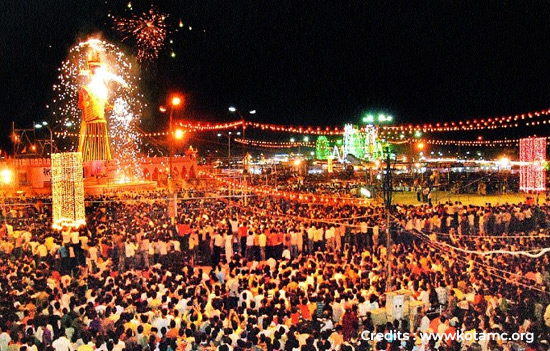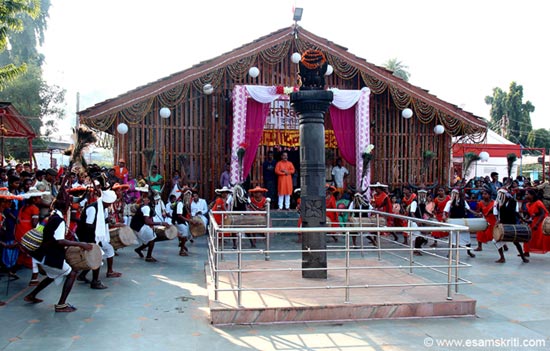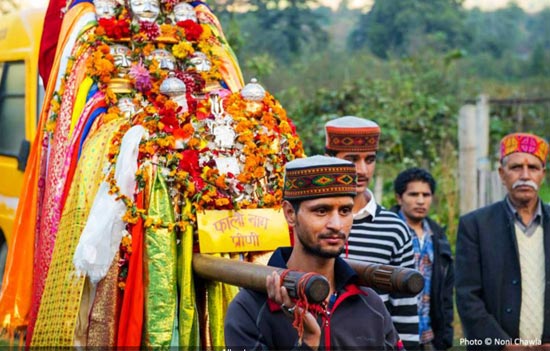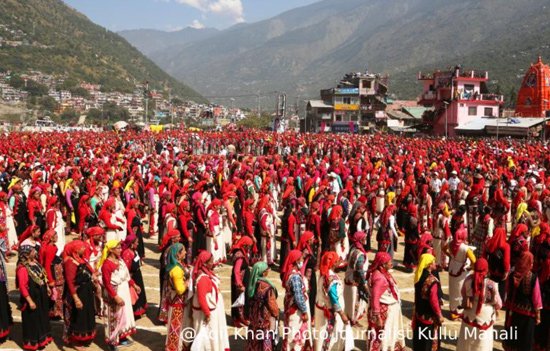- Know about types of Navaratri-how
it is celebrated in Delhi/Tamil style- Kanya pujan-Ram Lila-Names of 9 Devis
worshipped and Dussehra celebrations across India.
Call it Navaratri or Durga Puja or
Chandi Puja or Shakti Puja. The puja of Durga is for worshipping three
dimensions of the feminine energy.
Swami Satyasthananda wrote in Prabuddha Bharata, “Of the diverse forms of worship prevalent in India from time immemorial, worship of the Divine Mother has occupied a place of singular significance. This idea of worshipping the Divine as the Eternal Mother has not been developed in any other religion of the world as it has been in the Hindu tradition and therefore it represents a unique contribution of Hindu thought to global religious culture.” Source
The first three days are devoted to
Maha
Kali, representing strength and power. On fourth, fifth and sixth day, Maha
Lakshmi is revered signifying wealth, energy and material well-being. The
seventh, eighth and ninth days are dedicated to Maha Saraswati, symbolising of knowledge
and dissolution.
The set of nine nights symbolizes
renewal and rejuvenation as it is associated with changing seasons.
Navaratri is of nine (nava) nights
(ratri) and ten days during which nine avatars of Shakti are worshipped.
The nine devis of Shardiya and Chaitra Navaratri
are Shailputri on Pratipada; Brahmacharini on Dwitiya; Chandarghanta on
Tritiya; Kushmanda on Chaturthi; Skand Mata on Panchami; Katyayani on Shashthi;
Kaalratri on Saptami; Mahagauri on Ashtami and Siddhidatri on Navami.
 Drone view of Garba Mahotsav in Baroda, Gujarat. 2022.
Drone view of Garba Mahotsav in Baroda, Gujarat. 2022.
Types of Navaratri
Navaratri is the only festival that is celebrated
twice a year - Shardiya Navaratri, Chaitra Navaratri. There are two more Navaratri
which are observed silently by those who wish to do sadhana, spiritual
progress, acquiring special siddhis - Magha Gupt Navaratri and Ashadha Gupt
Navaratri.
All names are according to the
Hindu months in which these appear. Shardiya Navaratri falls during
autumn in September-October, a month before Diwali. Chaitra Navaratri falls in the
first month of Hindu Panchang which comes in spring in March/April, after Holi.
Magha Gupt Navaratri comes in eleventh month of Hindu Panchang which comes in winters
in January/February. Ashadha Gupt Navaratri is in the fourth month of the Hindu
Panchang which comes in summers in June/July.
Chaitra Navaratri is
also called Vasanta Navaratri which is celebrated during the shukla paksha of chaitra maasa (month).
As it marks the first day of the Hindu calendar, it is a grand nine days
festival celebrated with great enthusiasm in Northern India. Chaitra is the
beginning of Hindu New Year. In Chaitra
Navaratri, the ninth day is celebrated as the birth day of Lord Rama. Sri
Vishnu appears as Sri Rama, the son of King Dashratha and Kaushalya,
culminating in Ram Navmi.
Navaratri in Delhi
Acharya Mahendra Prasad Naudiyal who teaches Sanskrit in a New Delhi Gurukul, says, “A day before Navaratri, pundits who are well versed in Sanskrit are engaged by families for nine days puja. Some families want only worship, others prefer only reading and chanting, while some want us to perform puja, reading, chanting, japa. A day before, i.e., on Mahalaya Amavasya, we go to homes to make Sarvatobhadra Mandal, a sacred geometric design made on white cloth with coloured rice and tied on a table.
Pratipada (first day) is a very hectic day as Ghatasthapana, Akhand diya and sowing Khetri has to be done at the right time. Ghatasthapana or Kalash sthapana, is an auspicious tradition of putting a pot full of water along with mantras inviting Durga to come to the home and shower blessings. Akhand diya is an oil or ghee lamp/jyoti that burns uninterrupted for nine days. Khetri is sowing barley (jawar) in a fresh new clay pot filled with sand. In nine days higher the khetri grows, more is the prosperity in coming years. All this has to be done in the stipulated time so we rush from one place to another.
 Acharyaji.
Acharyaji.
Timing of puja is fixed as it has to be done at a fixed time; with invocation of each deity, offerings flowers, betel leaves and betel nuts. Worshipping Durga, and all the devi-devatas, all nine grahas, reading Durga Saptashati, japa, arati, bhoga takes three hours. I start this ritual from my own home and then go to three families. From 5 am to 9 pm, I complete everyone’s puja and remain on fast. On last day we do havan. Some families want the havan on ashtami night, some on navami morning and some on navami night.
So my fast continues till all havan are done and then on Vijaydashami
we do Ayudha puja i.e., shastra puja. Shopkeepers, business men, engineers want us to do puja for their computers, machinery, cars, and buses. So, I break my fast only on Vijayadashami.”
Durga Puja in Offices
Durga being a female form, this festival is a favourite of
ladies. In many offices, during lunch hours, ladies gather for singing and
dancing. Ladies room echoes with dholak, clapping and everyone singing, “Taaliyan bajao saare taaaliyan bajao,
khushiyan manao saare khushiyan manao, har koi aiyo bole, Meri maa ne aana (Clap your hands everyone, be happy everyone, everyone is saying, my mother is coming). Devotional songs are sung to greet her and most songs are a list of wishes to be fulfilled for she being Maya, can fulfil all their wishes. It is a lovely sight as all ladies dress up in red which is Durga’s favourite colour and bring sweets and fruits for her.
The story is that Parvati is coming from her husband Siva’s home Kailash to Mrityu loka on her Vahana, which is her maternal home. Parvati is welcomed by her father Himavan, mother Menavati, friends, neighbours, relatives who are very happy that their daughter has come back to meet them. Huge celebrations in temples are arranged, shops are decorated, bazaars are lit, and homes are cleaned to welcome Parvati.
 Durga Puja, Kolkata.
Durga Puja, Kolkata.
In Ramakrishna Mission, Durga Puja refers to the six days observed as Mahalaya, Shashthi, Maha
Saptami, Maha Ashtami, Maha Navami and Vijayadashami. In Kali Bari, where Bengalis are
predominant, Pandals of Durga are put up along with Lakshmi and Saraswati. While the Bengalis celebrate with lots of food, natives
of North keep a strict fast.
Read about Durga
Worship in Prabuddha Bharata
Read First-hand
experiences of how Durga Puja is celebrated in Kolkata and names/importance of
each day of Durga Puja celebrations in West Bengal
Those who don’t fast maintain a vegetarian diet and abstain from alcohol. Many men don’t shave, cut hair or nails these nine days signifying that they are praying for Durga who is busy fighting demons. Whether one is feasting or fasting, everyone worships
Goddess Durga by chanting, visiting Shakti temples or by meditating. Many devotees fast on Pratipada and Ashtami
only while some fast for the entire nine days.
Fasting implies abstaining from
grains, taking only preparations made of buckwheat, sago and potatoes instead.
Fasting is sadhana, efforts by human beings to increase their spiritual
prowess.
It is a matter of great
pride for us that Prime Minister Narendra Modi
religiously keeps strict fasting on Chaitra and Sharadiya Navaratri. According to media reports available, PM Modi has been drinking only lemon water and plain water in Navratri fasting for the last forty years without fail. Despite holding the country’s most important and busiest office, the PM makes sure that he observes the Navratri vrat.
Ramayana Recital
Sri Rama,
Lakshman, Hanuman and the whole Vanara Sena worshipped Ma Durga for nine days
from Pratipada to Navami and then attacked Lanka on Dashami. So temples organise Ramayana Parayanam of
nine days which is considered very auspicious. Parayanam means reciting the
entire Ramcharitmanas
by Tulsidas in nine days. From start to end, Ramcharitmanas is read by devotees who take turns in reading it. On
the last day a havan is done signifying the completion of the epic.
 Ram Leela in Kumaon. Couresty C S Tewari.
Ram Leela in Kumaon. Couresty C S Tewari.
 Ram Leela in Ramnagar, near Kashi.
Ram Leela in Ramnagar, near Kashi.
Some temples organise Ramleela
which is the highlight of Sharadiya Navaratri. Ramleela is a
nine day dramatic enactment of the life of Sri Rama based on the Hindu epic Ramcharitmanas
by Tulsidas. It is performed in theatres, temples, temporary stages, community centres and open areas. Ramleela is played in UP, Delhi, Uttarakhand, Bihar and Madhya Pradesh. Major portions of Sri Rama’s life are performed as drama or in the form of song and dance by young actors elaborately costumed. Children
love Shardiya Navaratri. They have a gala time watching Ramleela, buying vanara masks, bow and arrow, crackers
and acting the parts of Vanara sena amongst them.
Read in Hindi Ramleela
in Kumaon
Another
prominent ceremony involving children is Kanya pujan or Kanjak puja.
 Kanya pujan, Bastar. 2018.
Kanya pujan, Bastar. 2018.
It takes place on the eighth or ninth day, depending on every family’s tradition. Small girls aged 2 to 12 are worshipped to please Goddess Durga. Usually nine girls are invited signifying nine devis. Their feet are cleaned with water, Kalawa, holy thread is tied around their
wrists, a tilak of red kumkum, and akshat is
applied to their forehead. They are given sweets, puri, kala chana, halwa and
gifts such as red chunri, bangles, and toys, ornaments.
It is believed that
Goddess Durga manifests in little girls. Kalasura was killed by Durga in the
form of a young girl, Vaishno Devi showed herself as a small girl. So, little girls are worshipped along with
one boy representing Bhairava nath. In
different colonies, small girls come in groups dressed in red lehngas or frocks
and wait for families to invite them.
Navaratri,
Tamil style

Krathu wrote, “When most people think of the festival, they may think of fasting and of Garba and Dandiya, the dancing of Gujarat. That’s one way of celebrating, but not how everybody observes this grand festival. In Southern India, we observe it in a very significant way by making a Golu Bommai, literally “display of dolls.” To
read more
Vijaya dashami / Dussehra
The tenth day is very hectic for devotees, for pundits
and children as well. In the morning, khetri has to be immersed in a water body
or put under a peepal tree, akhand diya has to be finally laid to rest, and
holy water from the kalash/pot has to be sprinkled in the home, factory or
office. Devotees rush to temples to leave their khetri in the temple premises,
place the akhand diya in a proper place where it will fade away on its own
gradually and make their homes sacred by sprinkling the water from the kalash.
This tenth day is
called Vijaya
dashami. Vijaya means victory and dashami
means tenth. It is a day of farewell and exit,
of grief and joy, of leave-taking and destruction. Devotees are sad that their
daughter Parvati is leaving them on Vijayadashami. In the morning of Vijaya Dashami, Ma Durga is
sent off by her parents and friends back to Kailash via the river. Statues of Goddess Durga, Saraswati
and Lakshmi are finally immersed in rivers on the 10th day. Loads of buses
carrying devotees and the idols leave the pandals with devotional music
playing. After ten days of festivity devotees
bid Parvati a teary farewell, yet there is happiness in the hearts that the
demons will be killed in the evening.
This is the best gift
that Parvati bestows on devotees on the last day.
 Burning effigy of Ravana, Kota in Rajasthan.
Burning effigy of Ravana, Kota in Rajasthan.
Evening time is for celebrations
because good will triumph and evil will be defeated. On the tenth day
the demons are killed by Sri Rama. Huge effigies
of Ravana and his brothers Kumbhakarna and Meghanada are burnt symbolising the victory of good over evil. It is considered
an auspicious time for students to begin educational or artistic
pursuits. With tears and smile, Parvati is sent off to rejoin Siva and the
demons are destroyed forever. Nine days are a very short period to be with
Parvati but the consolation is that Parvati will come again at the next
Navaratri.
 Mysore Palace, Karnataka lit up during Durga Puja/Dussehra.
Mysore Palace, Karnataka lit up during Durga Puja/Dussehra.
The city celebrates Ma Chamundeswari’s victory over Mahishasura. Celebrations are around the Mysuru Palace i.e. fully lit up. Local wrestlers fight within the palace premises. The current Wodeyar King (titular) rides on an elephant. Get to see lots of folk dance and enjoy music from different parts of Karnataka. Elephants start from the palace, go through the town to end at a stadium few kms away where an evening function is held.
Read about
Mysore Dussehra To see album of
Mysore Dussehra
 Members of the Bison Horn Maria community performing Gaur dance at Danteshwari Mandir.
Members of the Bison Horn Maria community performing Gaur dance at Danteshwari Mandir.
Dussehra is celebrated in Bastar over 75
days. Here no effigy of Ravana is burnt. Instead
the festival celebrates Ma Danteshwari and her reunion with sister Maoli Devi.
Celebration starts at Ma Danteshwari Mandir in Dantewada from where the procession moves to Jagdalpur’s Danteshwari Temple and around where rest of festival is celebrated. The erstwhile king of Bastar plays an important role (titular head) whilst the devotees and performers are all Adivasis who worship their own Gods and Goddesses.
To see album of
Bastar Dussehra
 Bringing the Goddess to Kulu. Courtesy Noni Chawla.
Bringing the Goddess to Kulu. Courtesy Noni Chawla.
Kullu Dussehra starts
when Dussehra ends in other parts of India. Locals in groups walk with their
Devis and Devatas to Kullu and camp in a maidan. Each devta has its own tent.
The Raja of Kulu leads the procession to install the image of Raghunath, the reigning
deity.
 Nati, the folk dance of Himachal, performed at Kullu during Dussehra.
Nati, the folk dance of Himachal, performed at Kullu during Dussehra.
 Shivaji Maharaj - Pratapgarh Fort lit up during Navaratri. Thanks Pritam. 2023.
Shivaji Maharaj - Pratapgarh Fort lit up during Navaratri. Thanks Pritam. 2023.
To read all
articles by author
Also
read
1. Nine
nights of women power
2. Why the Ramanagar Ramlila has an important place in India’s Art History
3. Ramnagar
Ramlila is a cultural extravaganza
4. Tradition
of Ram Lilas and Ram Kathas
5. Album
Tripura Sundari Mandir
6. Worship
of God as Mother in Indian Tradition